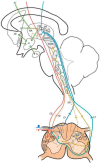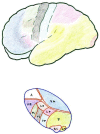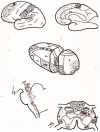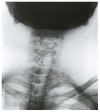Neurosurgical Treatment of Pain
- PMID: 36421909
- PMCID: PMC9688870
- DOI: 10.3390/brainsci12111584
Neurosurgical Treatment of Pain
Abstract
The aim of this review is to draw attention to neurosurgical approaches for treating chronic and opioid-resistant pain. In a first chapter, an up-to-date overview of the main pathophysiological mechanisms of pain has been carried out, with special emphasis on the details in which the surgical treatment is based. In a second part, the principal indications and results of different surgical approaches are reviewed. Cordotomy, Myelotomy, DREZ lesions, Trigeminal Nucleotomy, Mesencephalotomy, and Cingulotomy are revisited. Ablative procedures have a limited role in the management of chronic non-cancer pain, but they continues to help patients with refractory cancer-related pain. Another ablation lesion has been named and excluded, due to lack of current relevance. Peripheral Nerve, Spine Cord, and the principal possibilities of Deep Brain and Motor Cortex Stimulation are also revisited. Regarding electrical neuromodulation, patient selection remains a challenge.
Keywords: chronic pain; cingulotomy; cordotomy; deep brain stimulation (DBS); dorsal root entry zone (DREZ); mesencephalotomy; motor cortex stimulation (MCS); myelotomy; pain management; peripheral nerve stimulation (PNS); spinal cord stimulation (SCS); trigeminal nucleotomy.
Conflict of interest statement
The authors declare no conflict of interest.
Figures

















References
-
- Bonica J.J. The need of a taxonomy. Pain. 1979;6:247–252. - PubMed
-
- Leriche R. The Surgery of Pain. Williams & Wilkins; Baltimore, MD, USA: 1939.
-
- Bonica J. Pain. Raven Press; New York, NY, USA: 1980.
Publication types
LinkOut - more resources
Full Text Sources

